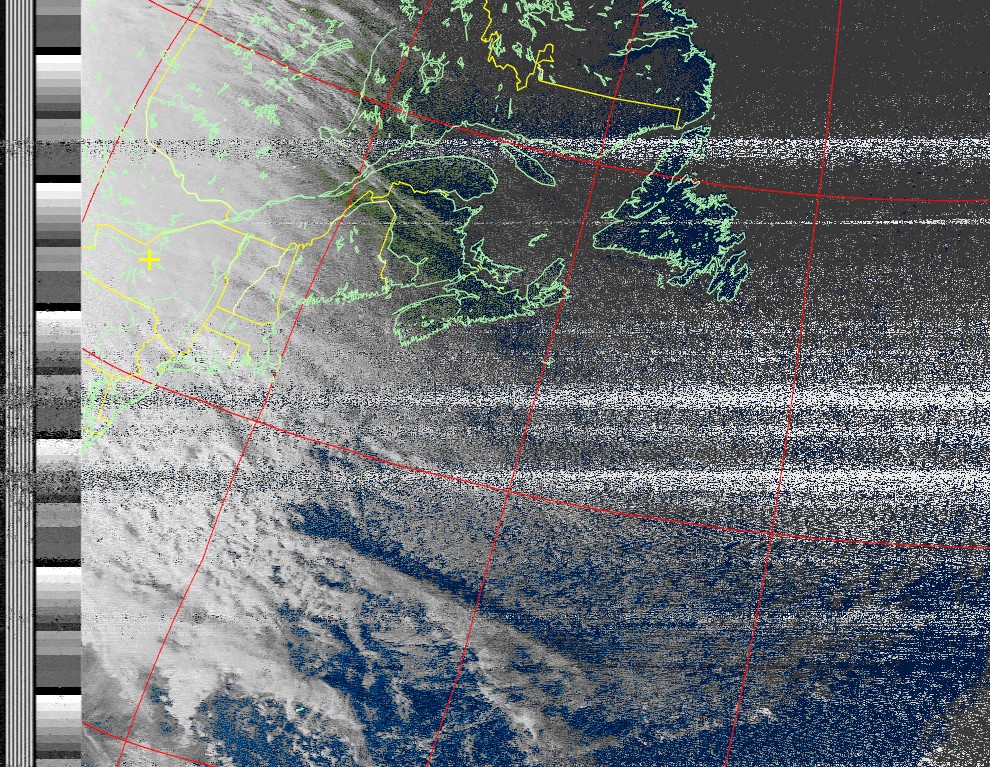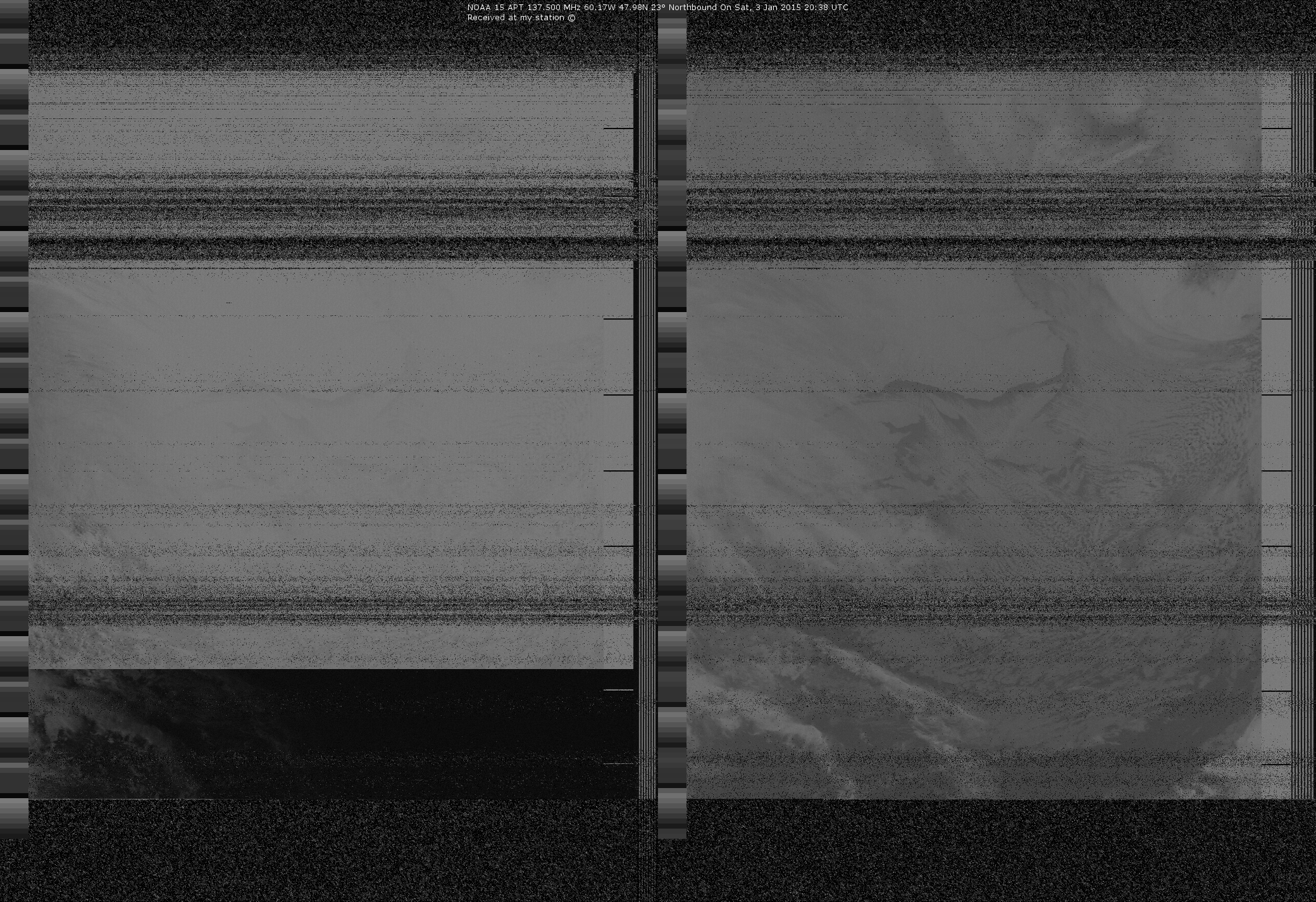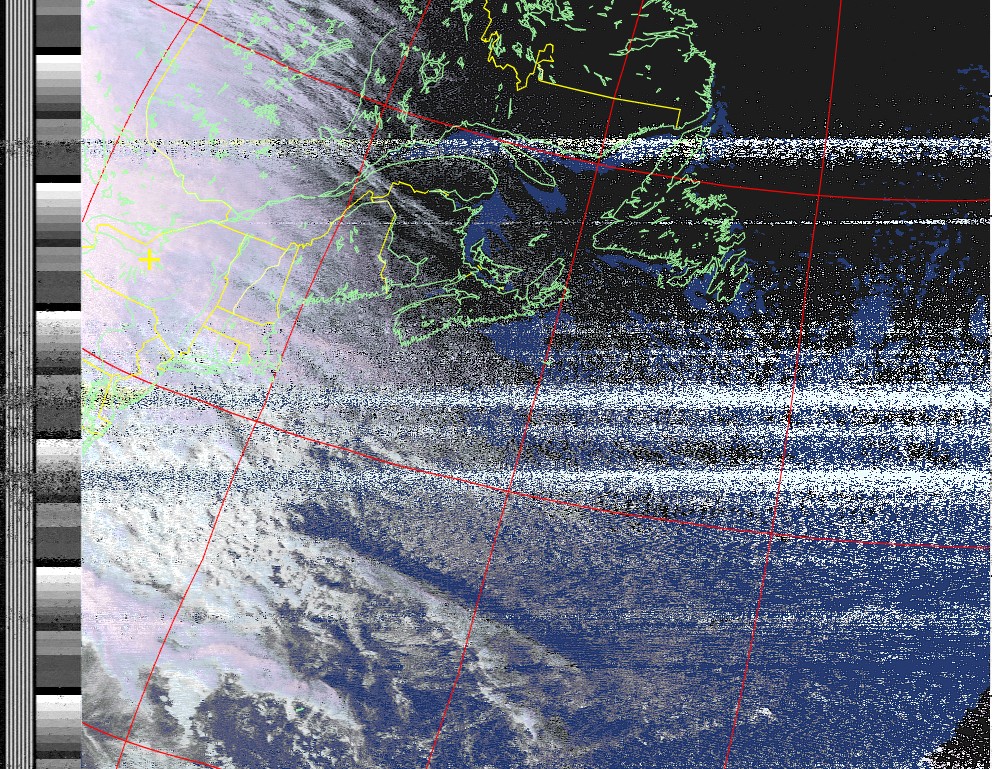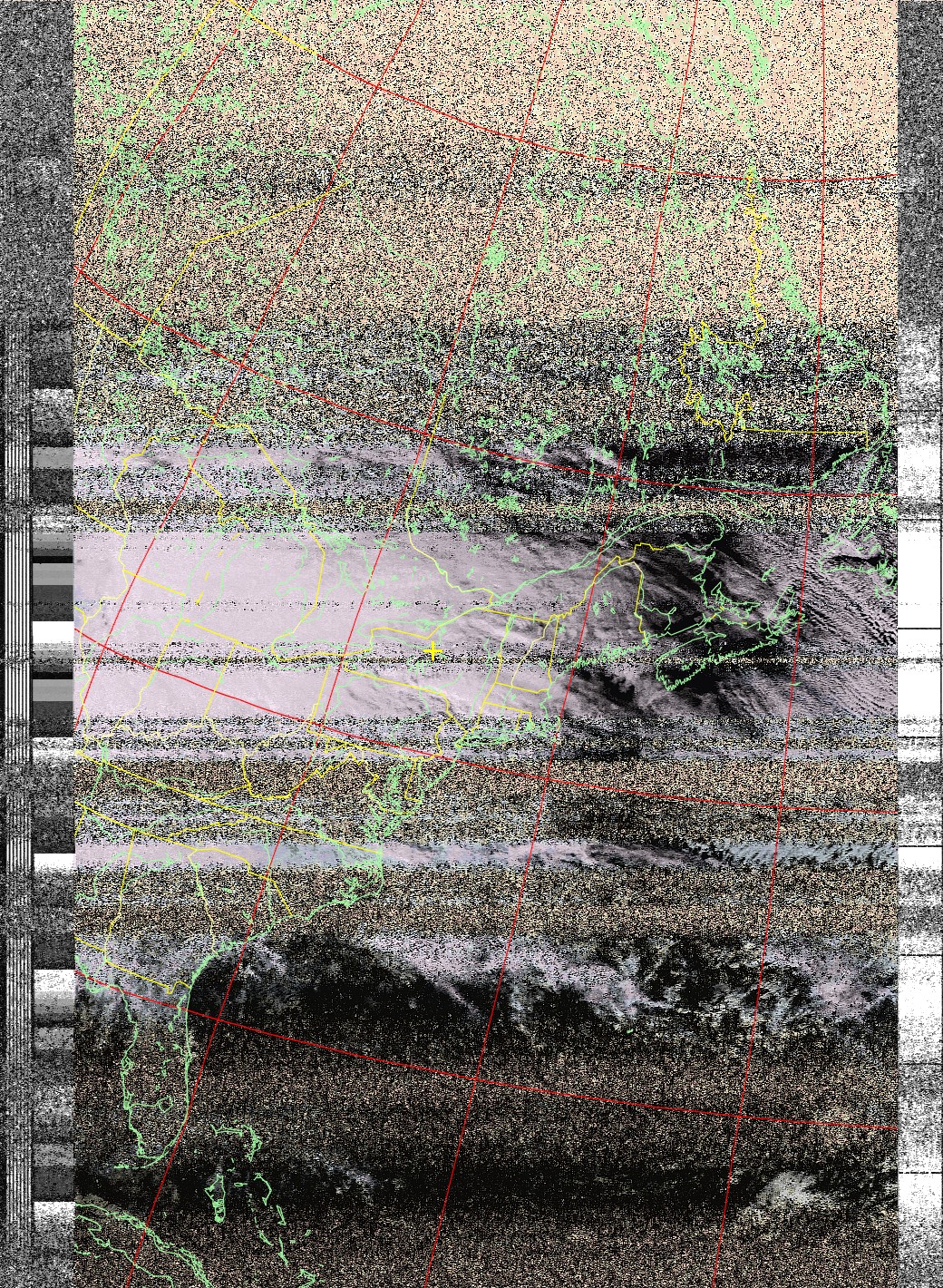It looks like you're using an Ad Blocker.
Please white-list or disable AboveTopSecret.com in your ad-blocking tool.
Thank you.
Some features of ATS will be disabled while you continue to use an ad-blocker.
1
share:
I recently started tracking NOAA polar orbital weather satellites, receiving and decoding their imagery data. I don't have a good antenna nor a good
location so I don't get the best coverage so pass timing is everything. I have my favorite little receiver hooked up to a preamp that is connected to
a 3/4 wave @ 137mhz dipole that is almost horizontal.
Right now I am experimenting with the angle on the antenna elements, and trying to figure out if I should have my broad side of the antenna facing the biggest viewing window i have. I'm really new to all of this and was wondering if there are any amateurs or scanner guys on here that could tell me how you do it.
I am not using anything fancy for the radio. Its just an RTL2832U with SDR# demodulating the signal and piping audio for me into WXtoImg.
Here are a couple images that i received and processed.




I couldn't get my software to do anything with this image after it recorded it. Refused spectral analysis and enhancements though it seemed like a great receive for me.


Let me know what you think and if you have questions, ill do my best to answer what i know.
Right now I am experimenting with the angle on the antenna elements, and trying to figure out if I should have my broad side of the antenna facing the biggest viewing window i have. I'm really new to all of this and was wondering if there are any amateurs or scanner guys on here that could tell me how you do it.
I am not using anything fancy for the radio. Its just an RTL2832U with SDR# demodulating the signal and piping audio for me into WXtoImg.
Here are a couple images that i received and processed.




I couldn't get my software to do anything with this image after it recorded it. Refused spectral analysis and enhancements though it seemed like a great receive for me.


Let me know what you think and if you have questions, ill do my best to answer what i know.
edit on 1/5/2015 by shaneslaughta because: (no reason given)
I don't have any recommendations or many questions - but my hats absolutely off sir - this is a magnificent 'intercept' and decoding performance -
I'd love to see what you turn up with after some refinement.
Truly epic.
Truly epic.
a reply to: DigitalJedi805
Tis a mere public service broadcast from the boys and girls at NOAA, with some help from NASA of course.
The imagery is actually quite simple. Just a grey scale image with false colors added and or contrast manipulation. To be honest, the software does it all pretty much. I just have to manually correct for doppler shift of the satellite while listening.
Tis a mere public service broadcast from the boys and girls at NOAA, with some help from NASA of course.
The imagery is actually quite simple. Just a grey scale image with false colors added and or contrast manipulation. To be honest, the software does it all pretty much. I just have to manually correct for doppler shift of the satellite while listening.
a reply to: shaneslaughta
Capturing NOAA LEO satellite APT signals is fun, I did this for years. Many older satellites have various operational problems contributing to your decoding problems. In addition, interference from the Orbcomm satellite constellation causes severe image corruption that can only be solved with the most sophisticated high-order bandpass filters.
A dipole antenna is not well suited for this application unless used with a tracker. Instead, build a simple quadrifilar helical antenna for 137 MHz using one of the many designs available on the internet.
The newest NOAA LEO satellite works great and uses a frequency far offset from the Orbcomm satellites. I eventually restricted my imaging to this satellite only.
Here is a great link to free APT resources and software: David Taylor
Best regards,
Z
Capturing NOAA LEO satellite APT signals is fun, I did this for years. Many older satellites have various operational problems contributing to your decoding problems. In addition, interference from the Orbcomm satellite constellation causes severe image corruption that can only be solved with the most sophisticated high-order bandpass filters.
A dipole antenna is not well suited for this application unless used with a tracker. Instead, build a simple quadrifilar helical antenna for 137 MHz using one of the many designs available on the internet.
The newest NOAA LEO satellite works great and uses a frequency far offset from the Orbcomm satellites. I eventually restricted my imaging to this satellite only.
Here is a great link to free APT resources and software: David Taylor
Best regards,
Z
It is amazing you get a decent signal like that with a simple indoor antenna. Do take a bit of coaxial cable and put your antenna outside; you´ll get
much less noise even with the simple dipole.
Well done!
Well done!
and the fun thing is that you can get a USB RTL-SDR for less then $15 ..
www.amazon.com...=sr_1_4?ie=UTF8&qid=1420517108&sr=8-4&keywords=USB+RTL
www.amazon.com...=sr_1_4?ie=UTF8&qid=1420517108&sr=8-4&keywords=USB+RTL
a reply to: DrZrD
I looked through the link you provided and the software on it. I cant get many of them to work because of missing dll's and what i believe to be the wrong OS. Seeing the age of some of the programs, I am thinking Window's XP
I did decide to make a quadrafiliar antenna and am preparing for test pass 1. "Crosses Fingers"
I am run through a preamp and the gain is set at 28 db in SDR# with lower noise floor than before. I still get a country station that pops in and out randomly that will be a problem.
I think I'm going to get some toroid cores and wrap all my cabling going to this system. Even at both ends of the coax.
a reply to: Pirvonen
It is an outside dipole, its just that I have a less than an optimum view of the horizon around me. Its a whole lot less that 360 degrees, and adjacent power lines 100% in my LOS. I also have an nearby FM station that hops off frequency a bit and right into 137.1 MHz. GRR 250 kHz worth of FM Stereo audio signal over the top of the 32 kHz ish satellite audio.
Indeed. There are a few places where you can get these things for under ten bucks, and there are several mods you can do to receive outside the stock limits of 14 MHz - 1.7 GHz. I seen that it can go down to something like a few hundred KHz. I'm tempted to grab a couple spares and give it a try.
I looked through the link you provided and the software on it. I cant get many of them to work because of missing dll's and what i believe to be the wrong OS. Seeing the age of some of the programs, I am thinking Window's XP
I did decide to make a quadrafiliar antenna and am preparing for test pass 1. "Crosses Fingers"
I am run through a preamp and the gain is set at 28 db in SDR# with lower noise floor than before. I still get a country station that pops in and out randomly that will be a problem.
I think I'm going to get some toroid cores and wrap all my cabling going to this system. Even at both ends of the coax.
a reply to: Pirvonen
It is an outside dipole, its just that I have a less than an optimum view of the horizon around me. Its a whole lot less that 360 degrees, and adjacent power lines 100% in my LOS. I also have an nearby FM station that hops off frequency a bit and right into 137.1 MHz. GRR 250 kHz worth of FM Stereo audio signal over the top of the 32 kHz ish satellite audio.
originally posted by: flyandi
and the fun thing is that you can get a USB RTL-SDR for less then $15 ..
www.amazon.com...=sr_1_4?ie=UTF8&qid=1420517108&sr=8-4&keywords=USB+RTL
Indeed. There are a few places where you can get these things for under ten bucks, and there are several mods you can do to receive outside the stock limits of 14 MHz - 1.7 GHz. I seen that it can go down to something like a few hundred KHz. I'm tempted to grab a couple spares and give it a try.
new topics
-
A Warning to America: 25 Ways the US is Being Destroyed
New World Order: 2 hours ago -
President BIDEN's FBI Raided Donald Trump's Florida Home for OBAMA-NORTH KOREA Documents.
Political Conspiracies: 8 hours ago -
Maestro Benedetto
Literature: 9 hours ago -
Is AI Better Than the Hollywood Elite?
Movies: 9 hours ago
top topics
-
President BIDEN's FBI Raided Donald Trump's Florida Home for OBAMA-NORTH KOREA Documents.
Political Conspiracies: 8 hours ago, 27 flags -
Weinstein's conviction overturned
Mainstream News: 17 hours ago, 8 flags -
Gaza Terrorists Attack US Humanitarian Pier During Construction
Middle East Issues: 14 hours ago, 8 flags -
Massachusetts Drag Queen Leads Young Kids in Free Palestine Chant
Social Issues and Civil Unrest: 16 hours ago, 7 flags -
Las Vegas UFO Spotting Teen Traumatized by Demon Creature in Backyard
Aliens and UFOs: 13 hours ago, 6 flags -
A Warning to America: 25 Ways the US is Being Destroyed
New World Order: 2 hours ago, 6 flags -
Meadows, Giuliani Among 11 Indicted in Arizona in Latest 2020 Election Subversion Case
Mainstream News: 16 hours ago, 5 flags -
2024 Pigeon Forge Rod Run - On the Strip (Video made for you)
Automotive Discussion: 14 hours ago, 4 flags -
Is AI Better Than the Hollywood Elite?
Movies: 9 hours ago, 3 flags -
The functionality of boldening and italics is clunky and no post char limit warning?
ATS Freshman's Forum: 15 hours ago, 1 flags
active topics
-
Gaza Terrorists Attack US Humanitarian Pier During Construction
Middle East Issues • 33 • : FlyersFan -
Weinstein's conviction overturned
Mainstream News • 24 • : burritocat -
-@TH3WH17ERABB17- -Q- ---TIME TO SHOW THE WORLD--- -Part- --44--
Dissecting Disinformation • 690 • : burritocat -
University of Texas Instantly Shuts Down Anti Israel Protests
Education and Media • 266 • : SchrodingersRat -
New whistleblower Jason Sands speaks on Twitter Spaces last night.
Aliens and UFOs • 66 • : baablacksheep1 -
HORRIBLE !! Russian Soldier Drinking Own Urine To Survive In Battle
World War Three • 50 • : F2d5thCavv2 -
Russia Ukraine Update Thread - part 3
World War Three • 5732 • : F2d5thCavv2 -
The Acronym Game .. Pt.3
General Chit Chat • 7751 • : F2d5thCavv2 -
Salvador Dali's Moustaches
People • 28 • : zosimov -
Is AI Better Than the Hollywood Elite?
Movies • 17 • : ThePsycheaux
1
